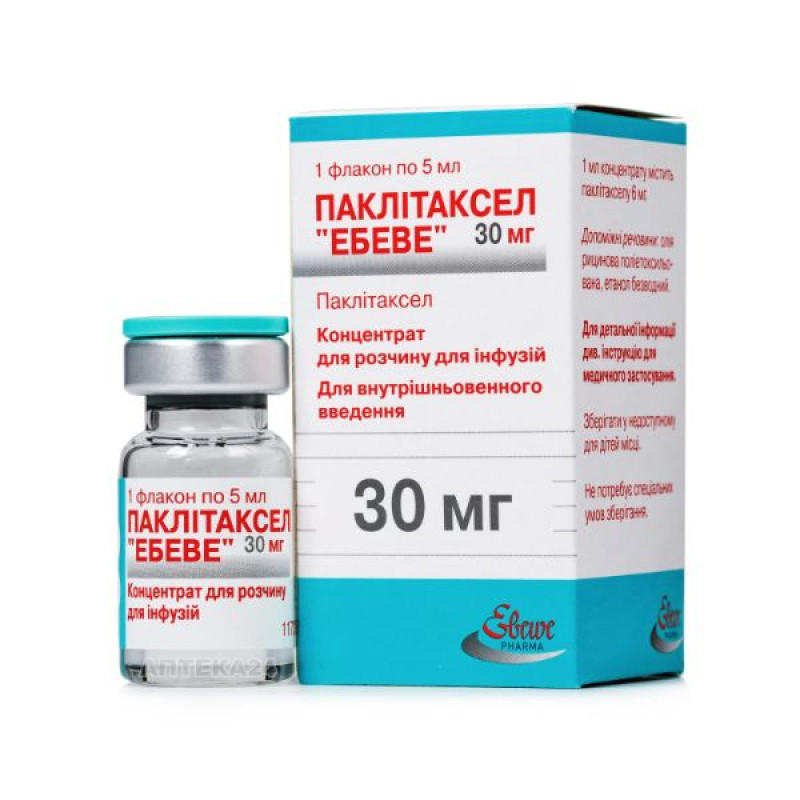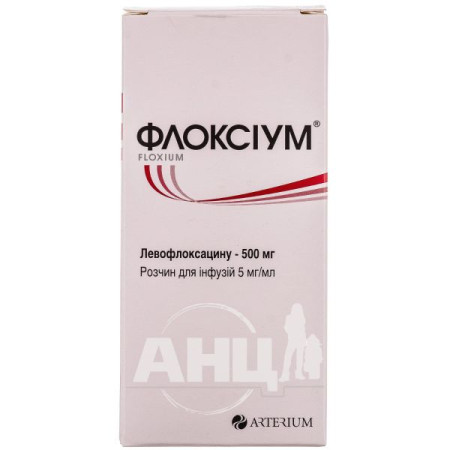Paclitaxel Ebeve concentrate for solution for infusion 30 mg vial 5 ml No. 1

Paclitaxel "Ebeve" concentrate for solution for infusion is used for the following indications:
ovarian cancer (first-line chemotherapy for the treatment of ovarian cancer, as well as in combination with cisplatin for advanced disease or residual tumors (more than one cm in size) after laparotomy; second-line chemotherapy for metastatic ovarian cancer when standard platinum therapy is ineffective); breast cancer (adjuvant chemotherapy of patients with lymph node involvement after standard combination therapy with anthracyclines or cyclophosphamide, primary chemotherapy of locally advanced or metastatic breast cancer in combination with anthracyclines or in combination with trastuzumab in case of immunohistochemical overexpression of HER-2 oncoproteins (3+) or in case of contraindications to anthracycline therapy; monotherapy of metastatic breast cancer in patients who are not candidates for standard anthracycline therapy or in case of ineffectiveness of previous anthracycline therapy); advanced non-small cell lung cancer (NSCLC) (combined chemotherapy with cisplatin in case of impossibility of surgical treatment and/or radiotherapy); Kaposi's sarcoma in AIDS patients (second-line therapy for advanced Kaposi's sarcoma in case of ineffectiveness of previous therapy with liposomal anthracyclines).Composition
Active ingredient: paclitaxel;
1 ml of concentrate contains 6 mg of paclitaxel;
Excipients: polyethoxylated castor oil, ethanol.
Contraindication
Hypersensitivity to paclitaxel or other components of the drug, especially to polyethoxylated castor oil; pregnancy and lactation; neutropenia before the start of treatment (initial neutrophil count <1.5 × '10 9 / l, in the case of Kaposi's sarcoma in AIDS patients, the neutrophil count <1 × '10 9 / l), thrombocytopenia (<100 × '10 9 / l); concomitant severe uncontrolled infections in patients with Kaposi's sarcoma; severe liver dysfunction.Method of application
Before starting treatment with the drug, all patients should receive premedication with corticosteroids, antihistamines, and H2-receptor antagonists.
Paclitaxel solution should be administered intravenously via infusion systems with built-in membrane filters with a pore size ≤ 0.22 μm.
Application features
Pregnant women
There is no information on the use of paclitaxel in pregnant women. As with other cytotoxic drugs, paclitaxel may cause fetal harm and should not be used during pregnancy. Women and men should use contraception to prevent pregnancy during treatment with paclitaxel and for at least 6 months after treatment with paclitaxel, and should inform their doctor immediately if pregnancy occurs. Breastfeeding should be discontinued during treatment with paclitaxel.
If necessary, cryopreservation of sperm in men should be performed before starting paclitaxel treatment due to the possible development of infertility.
Children
The safety and efficacy of paclitaxel in children have not been established, therefore paclitaxel is not recommended for use in this category of patients.
Drivers
During treatment with paclitaxel, one should refrain from potentially hazardous activities that require increased concentration and quick reactions. It should be borne in mind that the drug contains ethanol, and some side effects may adversely affect the ability to drive vehicles or operate complex mechanisms.
Overdose
Symptoms: The main expected complications of overdose are bone marrow suppression, peripheral neuropathy, and inflammation of the mucous membranes.
Treatment: In case of overdose, the drug should be discontinued immediately and symptomatic treatment should be carried out with monitoring of blood cell counts and vital organ function. There is no known antidote for paclitaxel.
Side effects
The most common side effect of paclitaxel treatment is bone marrow suppression.
Interaction
In combination chemotherapy for first-line ovarian cancer, paclitaxel should be administered before cisplatin. In this case, the safety profile of paclitaxel does not differ from that of monotherapy. If paclitaxel is administered after cisplatin, more severe myelosuppression is observed, and paclitaxel clearance is reduced by approximately 20%. The risk of developing renal failure in patients with ovarian cancer receiving combination therapy with paclitaxel and cisplatin is higher than with cisplatin monotherapy.
Since the elimination of doxorubicin and its active metabolites may be reduced by shortening the time interval between paclitaxel and doxorubicin administration, in the primary chemotherapy of metastatic breast cancer, paclitaxel should be administered 24 hours after doxorubicin.
Storage conditions
Does not require special storage conditions.
Keep out of reach of children.
Shelf life - 3 years.
There are no reviews for this product.
There are no reviews for this product, be the first to leave your review.
No questions about this product, be the first and ask your question.








